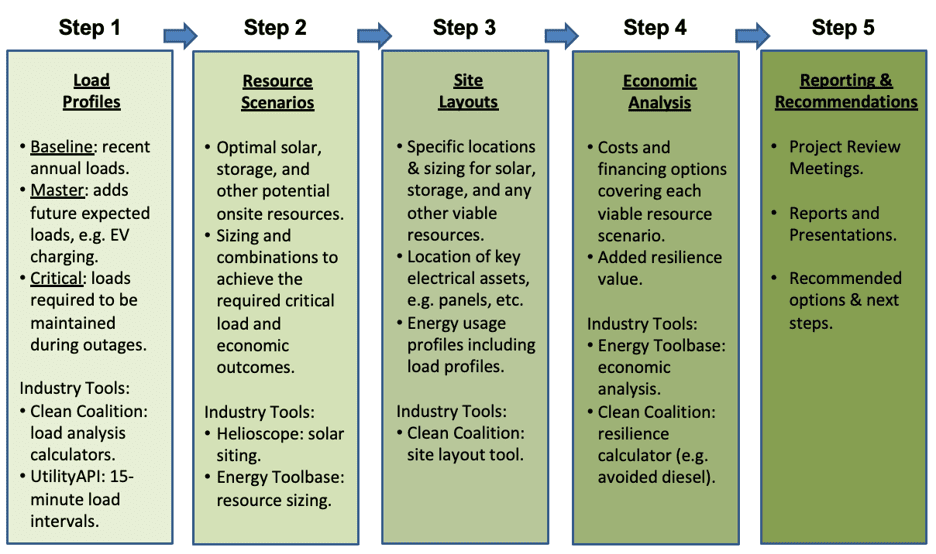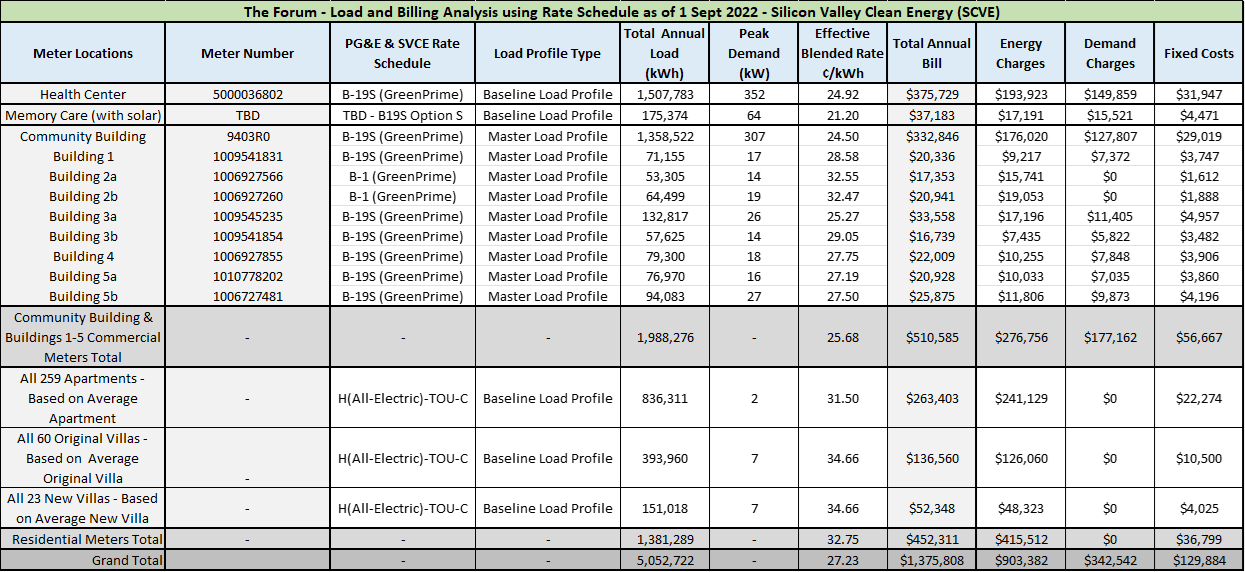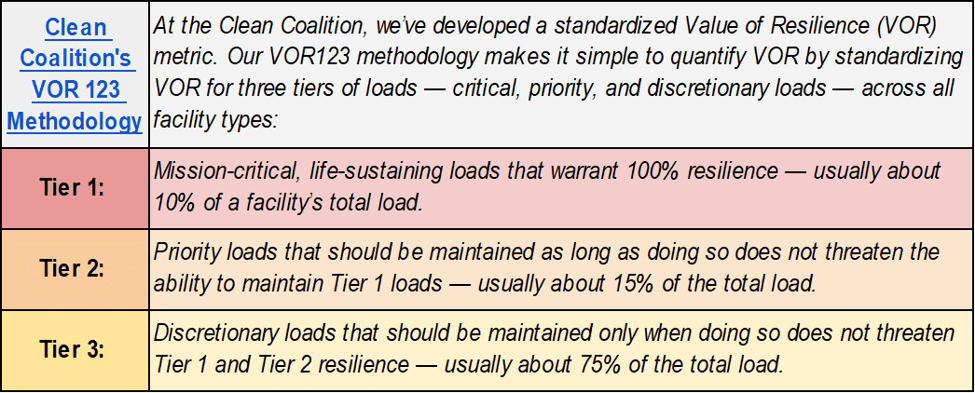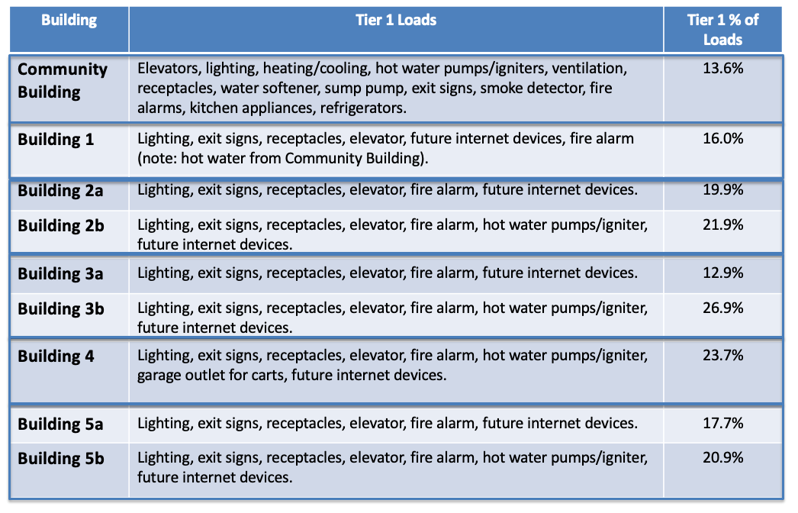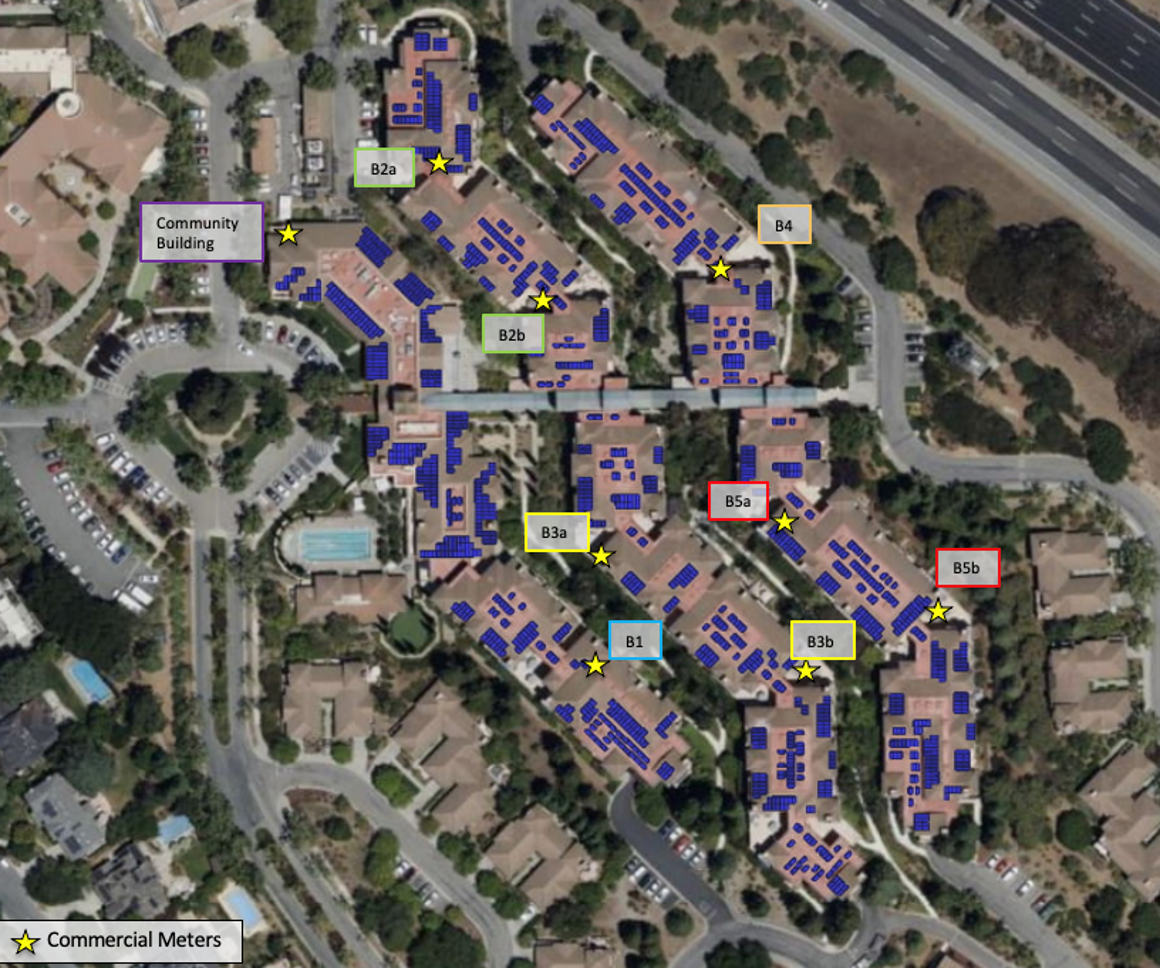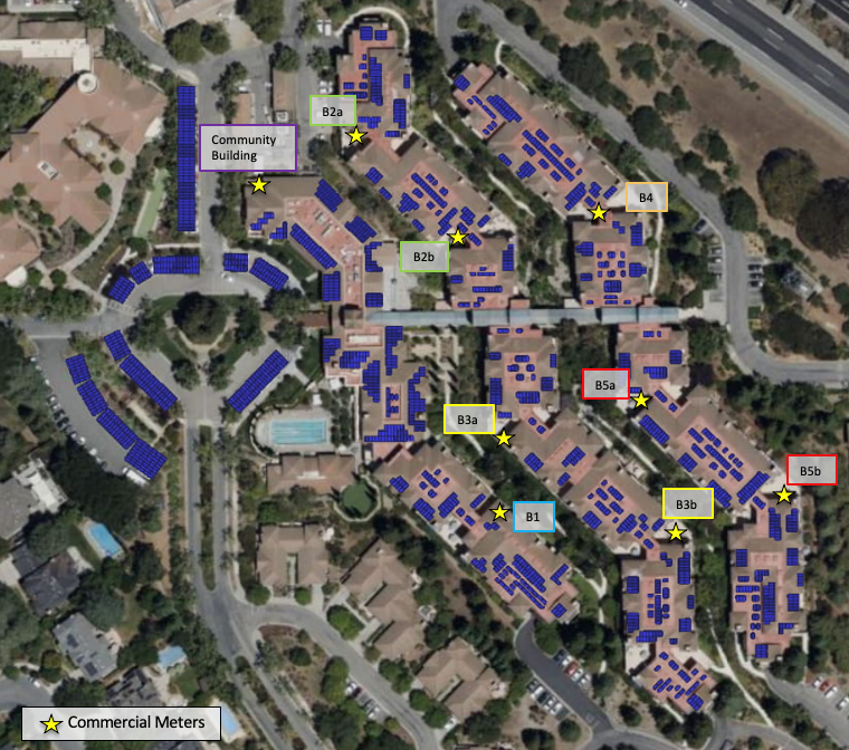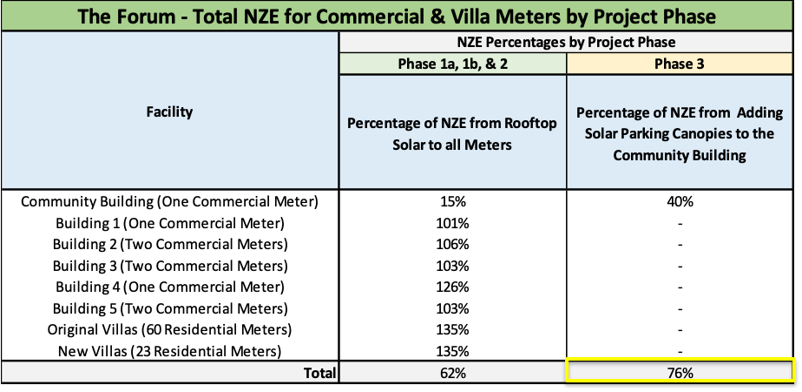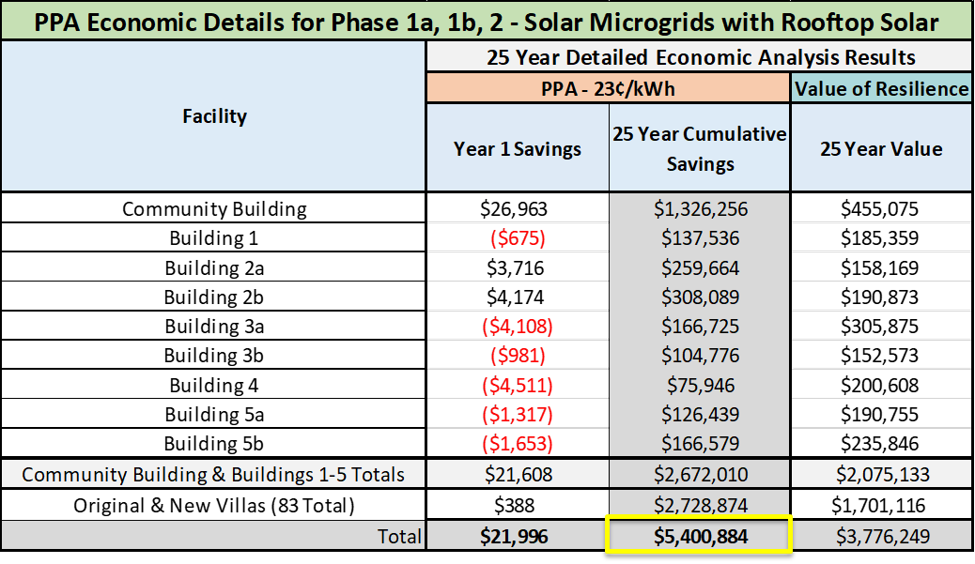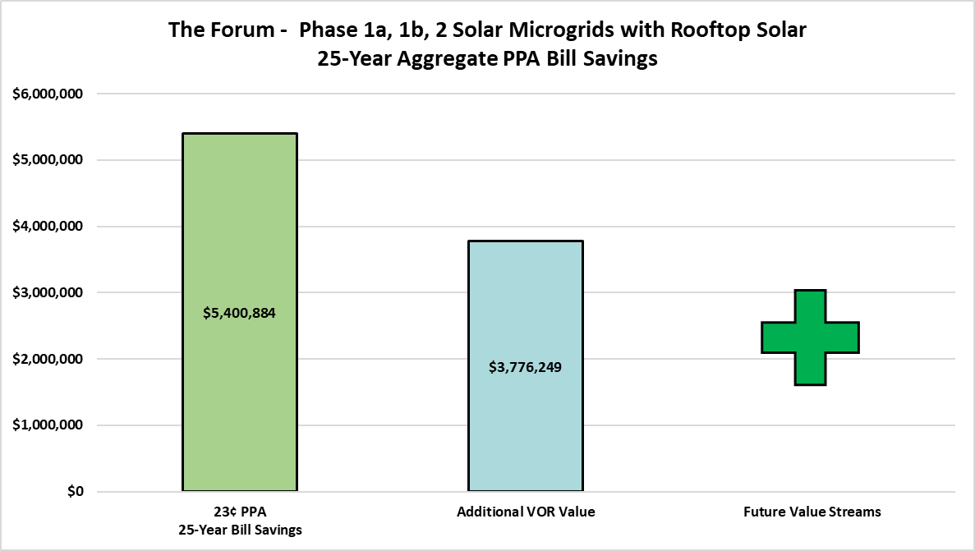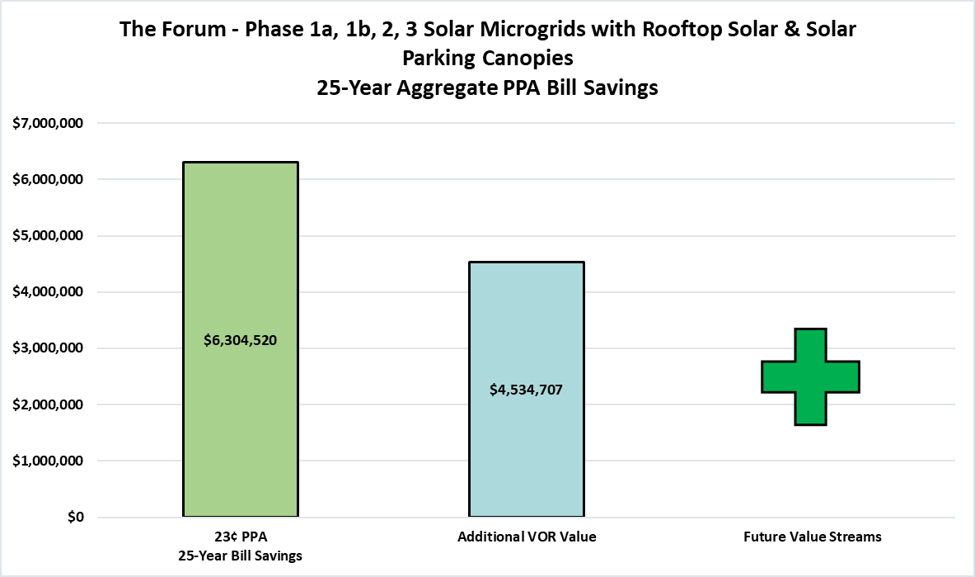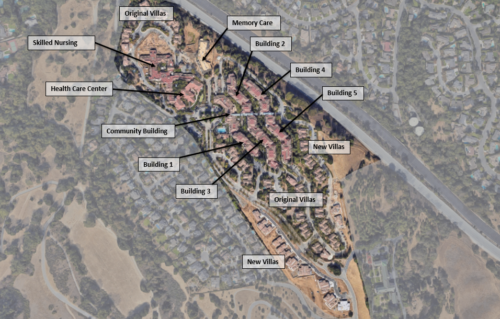
Solar Microgrids for The Forum proceeding to RFP
The Clean Coalition recently completed a standardized Solar Microgrid design for The Forum, a 350-unit full-service retirement community.

Solar Microgrids for The Forum proceeding to RFP
The Clean Coalition produced a detailed Energy Plan for a full-service retirement community showcasing that Solar Microgrids deliver an unparalleled trifecta of economic, environmental, and resilience benefits.
The Clean Coalition recently completed a standardized Solar Microgrid design for The Forum, a 350-unit full-service retirement community in Cupertino, California. The Clean Coalition applied its long-standing Solar Microgrid Methodology to this large retirement community, and the Solar Microgrids are now amidst a request-for-proposals (RFP) process that should result in implementations by year-end 2023.
With the increasing frequency of disasters, awareness is growing quickly that energy resilience is vital for communities everywhere. The benefits of Solar Microgrids are also on full display, and at the very least, Solar Microgrids should be deployed at Critical Community Facilities (CCFs) to ensure unparalleled resilience – along with economic and environmental benefits – for essential services during grid outages of any duration.
The Clean Coalition facilitates Solar Microgrid and Community Microgrid projects that can be replicated anywhere. By showcasing the feasibility of these projects, and the vast potential for siting distributed energy resources in the built environment, we help proliferate clean local energy and community resilience. The Clean Coalition bases its work on concrete project experience – and helps to innovate policies that often impede these projects.
The specific results and recommendations in this study will enable The Forum to proceed with the construction of the Solar Microgrids at their facility in Cupertino, delivering these two significant benefits:
- Providing critical resilience – keeping essential services such as freezers & refrigerators, security, internet access, and fire and life safety systems.
- Improving The Forum’s budget – providing over $6.3 million in savings on The Forum’s electricity bill under a Power Purchase Agreement (PPA) that requires no upfront capital, while adding an additional almost $4.5 million in value-of-resilience (VOR) based on the Clean Coalition’s streamlined VOR methodology that groups loads into three tiers and is therefore known as VOR123.
The Forum engaged the Clean Coalition to conduct a detailed feasibility analysis, produce recommendations, and subsequently, to design and lead an RFP process. The RFP process is nearing the selection of a winning Engineering, Procurement, and Construction (EPC) provider and a Power Purchase Agreement (PPA) financier. The Clean Coalition is attempting to ensure that the timing of the RFP process will enable The Forum’s Solar Microgrids to be grandfathered into Net Energy Metering 2 (NEM2) tariffs, which are considerably more favorable than the NEM3 tariffs that are anticipated to be approved by the CPUC on 15 December and apply to all projects that do not have utility-approved applications by 10 April 2023. Importantly, an application can be submitted toward the frontend of a Solar Microgrid project, as soon as the solar and storage sizing is completed and a simple single-line drawing has been produced.
The Forum’s onsite energy solution will serve the commercial meters in the Community Building and the five apartment-style buildings (Buildings 1-5) that will be re-roofed. Additionally, the solution will serve the individually metered residential Villas that are essentially single-family residences sited along the property perimeter. The combination of the Clean Coalition’s technical and site design details along with managing the RFP process will achieve the best outcome for The Forum.
The remainder of this piece goes into the details of the The Forum Solar Microgrid feasibility study process and the key results.

The Forum retirement community started in 1991 with a dream to create a Life Plan Community truly owned and governed by residents. The Forum is located next to Rancho San Antonio County Park and Open Space Preserve with its diverse environments, breathtaking landscape and extraordinary views. They are fortunate to be in this location with their unique equity ownership model; however, as they state, their greatest asset is their people: the staff members and residents who give so much to the community on a daily basis.
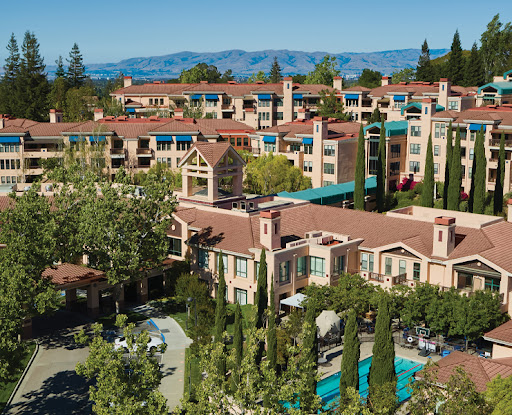
The Forum has fully recognized the need for a truly modern energy solution that satisfies the needs of its retirement community. Their stated goal is a cost-effective campus-wide energy plan optimizing onsite solar production and storage of the solar produced onsite, including resilience for critical loads. This energy plan must help achieve their objectives of carbon neutrality and resilience, while supporting the outcome of a net carbon-neutral built environment by 2030. The required outcomes of the plan are to achieve the following:
- The most optimal onsite energy mix based on a Solar Microgrid supporting existing loads and the addition of EV Charging Infrastructure (EVCI).
- Substantial resilience, including indefinite resilience for the most critical loads and significant resilience for all other loads.
- Support a net carbon-neutral environment with an objective to achieve net zero electricity, as feasible.
- Optimize sequencing of the re-roofing, reconfiguring of meter arrangements, and Solar Microgrid elements.
- Maximize the economic benefits, recommending a financing option with no upfront cash outlay
The Forum Energy Plan is based on the Clean Coalition’s established Solar Microgrid design and optimization methodology that features energy resilience for essential services. The resilience goal is to enable indefinite operations of the most critical loads, while keeping all loads operational for a significant percentage of the time. This resilience would be provided when the grid is down for any reason, including from Public Safety Power Shutoff (PSPS) events, and more importantly, from actual disasters that require weeks or longer to restore grid service. The Solar Microgrids will also significantly reduce The Forum’s energy costs.
The scope and deliverables for the Solar Microgrid project at The Forum were as follows:
- Optimize the DER mix to:
- Achieve net zero energy.
- Maintain Tier 1 (critical) loads during grid outages and potentially indefinitely.
- Support Tier 2 (priority) loads as much as possible during grid outages, and whenever energy is plentiful, support Tier 3 (discretionary) loads too.
- Preempt the use of diesel and any other fossil fuels for resilience.
- Maximize economic benefits.
- Assess and evaluate Solar Microgrid ownership & financing options, including cash purchase and Power Purchase Agreement (PPA) options.
- Key deliverable: Presentations including the technical & economic analysis and recommendations.
The Clean Coalition conducted this study by utilizing its proven methodology for analyzing energy resource and resilience solutions on behalf of communities, featuring the following five steps:
- Step 1: Load Profiles: Develop profiles for existing electricity loads over a relevant 12 month period and then adjust for expected changes due to anticipated EV charging, electrification of heating applications and other appliances, and new construction. Also develop profiles for critical loads that need to be maintained for limited periods of time – and critical loads that need to be maintained indefinitely, regardless of grid outage durations.
- Step 2: Resource Scenarios: Investigate all possible onsite energy resource options that are technically viable for the site while optimizing the economic, environmental, and resilience objectives.
- Step 3: Site Layouts: Develop the site layouts to clearly illustrate recommended locations and sizing for all generation resources, locations for energy storage, and to detail locations of key electrical assets like the customer meter and critical loads.
- Step 4: Economic Analyses: Analyze the total costs and economic benefits of each of the viable Resource Scenarios at each site.
- Step 5: Reporting & Recommendations: Present the results and recommendations via project review meetings, presentations, and reports.
These five steps are diagrammed below:
Project Results
Load Profiles
For the Baseline Load Profile, due to the impacts of COVID-19, the calendar year 2020 was deemed most appropriate, and the Baseline Load Profile was determined using existing annual load data from The Forum in 2020. To calculate the Master Load Profile, the Electric Vehicle (EV) Charging Load Profile for the Community Building & Building 5b was determined, with the Community Building planning to add 4 Level 2 EV charging ports and Building 5b planning to add two Level 2 EV charging ports. The EV charging profile was modeled for typical usage 5+ years out using an employee + public EV charging load profile as follows:
In addition, Buildings 1-5 included a future load profile for new internet devices (IDF) being installed with a 2 kW consistent demand. The combination of the Baseline Load Profile, future electrical loads including electric vehicle (EV) charging, and the new internet devices produced the Master Load Profile. The following table lists the load profiles and resulting billing analysis for the Community Building and Buildings 1-5 at The Forum:
In addition, the following table lists the load profile that applies to all the locations relevant to The Forum Energy Plan. Note that specific locations are under a Baseline Load Profile since those locations are not anticipated to increase their loads due to adding EV chargers, etc. The table includes the Community Building and Buildings 1-5 along with all the Villas, and estimates the electrical bill costs for each location under the planned utility (PG&E) rates and Community Choice Aggregation provider (Silicon Valley Clean Energy) rates for The Forum. Note that the Total Annual Bill is broken up into the relevant sub-costs of Energy Charges, Demand Charges, and Fixed Costs.
Note that for the Villas, the total annual Baseline Load Profile is based on a sample Villa load profile, with the recommendation that the Master Load Profile target 135% of the existing average Villa load profile to include electrification from EV charging.
The critical load tiers are defined as follows:
The Forum’s Critical Load Profile was determined via a process that enabled the The Forum team to review all loads at the site and determine which loads fall into the three Tiers as defined above. This detailed process produced the following as the load tiering amounts for The Forum – the specific panels as applied to each Tier, and a sample of the actual loads per the detailed document that was used to list all the loads per Tier:

This load tiering analysis resulted in the following required critical load tiering percentages for The Forum’s Community Building and Buildings 1-5:
Note that the Critical Load Profile for the Villas is based on a common load amount required to serve residential locations during outages, and including the healthcare requirements typical for residential locations at a retirement community such as The Forum.
Resource Scenarios and Site Layouts
The following site layouts and accompanying Solar Microgrid profile data provides the resource scenarios for The Forum that satisfies the project’s clean energy, resilience, and cost savings goals. The complete resource sizing details for the Solar Microgrids are provided for all the relevant onsite locations covering the Community Building, Buildings 1-5, and the Original and New Villas.
The Forum has determined that these resource scenarios will most likely be implemented in the following phases:
- Phase 1(a): Rooftop solar serving Community Bldg and Bldgs 1-5. Resilience for critical loads. No changes to metering configuration.
- Phase 1(b): add Original Villas
- Phase 2: add New Villas
- Phase 3: add solar parking canopies
- Future: If deemed viable, add ground mount over the coming years; net zero and resilience provided to the entire site.
The following site layout shows the rooftop solar design for the Community Building and Buildings 1-5 as Phase 1(a) of The Forum’s Energy Plan:
The following table details the load profile type, solar siting potential, and resulting percentage of net zero the solar will deliver to the Community Building and Buildings 1-5:
For Phase 1(b), the following site layout shows the solar sizing for an example Original Villa:

For Phase 1(b), the following table lists the type of Original Villa units, the total annual projected Master Load (proposed as 125% of the existing load to accommodate future load amounts from EV charging), and the resulting percentage of net zero the solar will deliver to the Original Villas:
For Phase 2, the following site layout shows the solar sizing for an example New Villa:
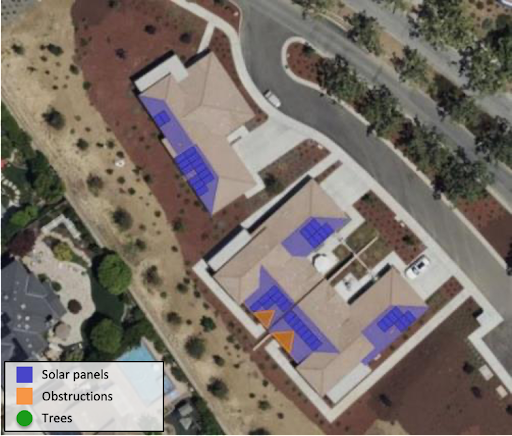
For Phase 2, the following table lists the type of New Villa units, the total annual projected Master Load (proposed as 125% of the existing load to accommodate future load amounts from EV charging), and the resulting percentage of net zero the solar will deliver to the New Villas:
For Phase 3, the following table adds the solar parking canopy amount delivered to the Community Building and combined with the Community Building rooftop solar, with the resulting percentage of net zero the solar will deliver using the Master Load Profiles for the Community Building and Buildings 1-5:
For the Community Building, the following tables provide the optimal energy storage sizing and indefinite resilience percentages under Phase 1(a) – rooftop solar only – and under Phase 3 – rooftop solar combined with the solar parking canopies. Note that all battery sizes are configured for Time-of-Use (TOU) arbitrage and demand charge management. The optimal battery size is based on the resilience requirement, which would be met if solar parking canopies were added. If not, the battery size would be so large it would become uneconomical. Note that in order to cover all loads during an outage, a battery’s power capacity needs to be at or above a meter’s peak demand:
An example of the appropriate energy storage system for the Community Building is a Tesla Megapack or of similar capacity with microgriding capabilities:

For Buildings 1-5, the following table lists the proposed battery sizing and resilience under Phase 1(a). All battery storage sizes are based on a multiple of Tesla Powerwalls with each Powerwall having a power capacity of 5 kW and energy capacity of 13.2 kWh. Note that all battery sizes are configured for Time-of-Use (TOU) arbitrage and demand charge management. The optimal battery sizes are based on the resilience requirements. Note that in order to cover all loads during an outage, a battery’s power capacity needs to be at or above a meter’s peak demand:
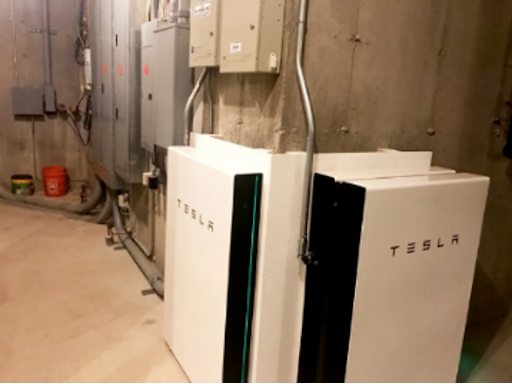
For both the Original Villas and New Villas, the following table lists the proposed battery sizing and resilience under Phases 1(b) and 2:
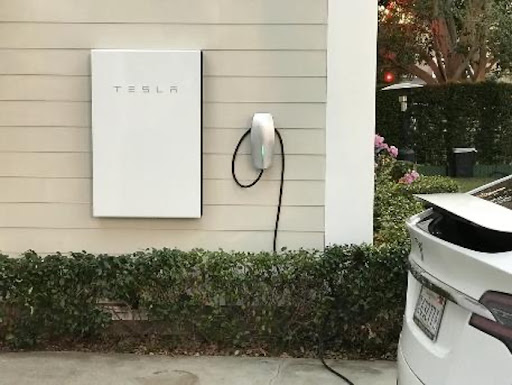
In addition to the solar and storage, the following table lists the number and type of Load Management Systems for The Forum’s Energy Plan:
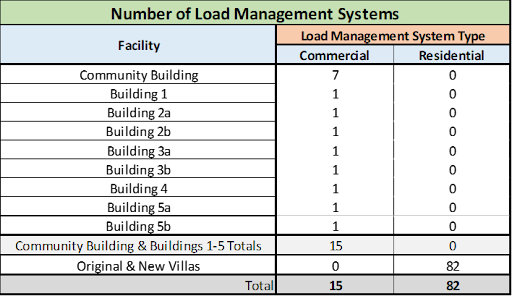
The following table provides the summary list of solar and energy storage sizing for all locations in The Forum’s Energy Plan: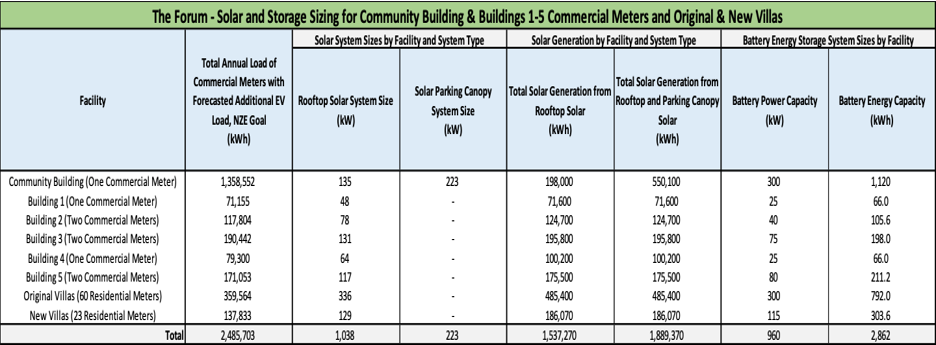
The following table provides the percentage of net zero energy for the Commercial & Villa meters as a result of the rooftop solar only phases – Phase 1(a), 1(b), and 2 – then as a result of adding the solar parking canopies in Phase 3:
Economic Analysis
Based on the Clean Coalition’s economic analysis of The Forum’s Solar Microgrids, and utilizing a Power Purchase Agreement (PPA) finance model as preferred by The Forum, The Forum will benefit from a net savings of over $5.4 million for over a 25-year period for the rooftop solar only phases, and over $6.3 million over a 25-year period for the rooftop solar plus adding the solar parking canopies. The complete 25-year Solar Microgrid PPA economic analysis for The Forum is provided below, and including the estimated Value of Resilience this solution will provide which is typically valued at 25% of the total electrical bill. The economics were modeled using a 3% utility escalator, Silicon Valley Clean Energy’s (SVCE’s) 100% GreenPrime rate, and appropriate solar+storage PG&E tariffs.
Note that the Year 1 and Cumulative Savings for the Original & New Villas are lower due to the solar sizing being designed to match the projected increased loads at the Villas over time. The bill savings will increase when the projected increases in loads occur due to electrification (e.g., Electric Vehicles, Hot Water Heat Pumps, etc.).
The following table and graph displays the economic results for rooftop solar only under Phases 1(a), 1(b), and 2:
The above analysis demonstrates that with rooftop solar only, The Forum will benefit from over $5.4 million in electrical bill savings, along with over $3.7 million in additional Value of Resilience, provided by the Solar Microgrids delivering the required resilience for the critical loads.
The following table and graph displays the economic results for both the rooftop solar and the solar parking canopies:
The above analysis demonstrates that with rooftop solar and the solar parking canopies, The Forum will benefit from over $6.3 million in electrical bill savings, along with over $4.5 million in additional Value of Resilience, provided by the Solar Microgrids delivering the required resilience for critical loads. This economic analysis demonstrates that The Forum can save substantial costs in utility bills by deploying these Solar Microgrids, while also benefiting from the Value of Resilience (VOR) that these solutions provide. The Energy Plan study completed for The Forum achieved the goal of providing a solution that delivers an unparalleled trifecta of economic, environmental, and resilience benefits.
As mentioned above, after delivering the detailed energy plan for The Forum, the Clean Coalition is now managing the Request for Proposal (RFP) process to establish a winning bidder who will implement the Solar Microgrids at the site. The RFP process engaged multiple potential bidders utilizing a qualifying proposal as the first step, then narrowing down the qualifying proposals to a short list of fully qualified bidders. Those bidders are currently preparing more detailed final proposals that are due in December 2022. As mentioned previously, the final proposals will be fully evaluated and scored, and the winning and backup proposers will be notified in January 2023 for implementation later in the year. The Clean Coalition is ensuring that the timing of the RFP process will enable The Forum’s Solar Microgrids project to be grandfathered into the Net Energy Metering 2 (NEM2) rules, which are considerably more favorable than the NEM3 rules that might be approved by the CPUC on 15 December and apply to all projects that do not have approved interconnection applications before tax day in mid-April.
The Clean Coalition’s technical and design expertise and details, combined with managing the RFP process, will deliver the best outcome for The Forum – demonstrating yet again that Solar Microgrids deliver an unparalleled trifecta of economic, environmental, and resilience benefits.

